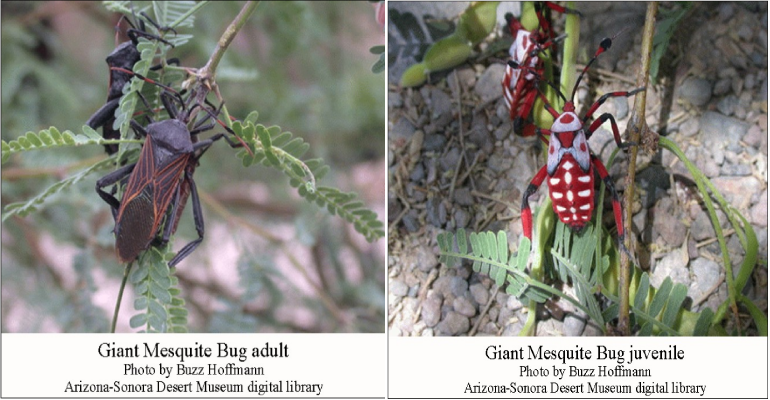
Giant Mesquite Bugs (Thasus gigas), also known as leaf-footed bugs, are out now. I saw the bright red and white nymph stage bugs on mesquite trees at the Arizona-Sonora Desert Museum last Sunday.
These are the largest true bugs in Arizona; they get just over one inch long. Adults are brown to black with orange-red bands on their legs and along veins of their wings. Several nymph stages are bright white and red. For photos of all five nymph stages, as well as photos of adults, see a post by Tucson biologist and artist Margarethe Brummermann here. That post also includes a brief description of the difference between beetles and true bugs. (True bugs suck.)
There are five nymph stages (called instars). The juvenile shown in the photo above is the fifth and last nymph stage. The sixth molt produces an adult with wings. The bright coloring of the nymphs is meant as a warning to predators that the nymphs are not good to eat.
Nymphs feed on mesquite leaves and pods and can often be seen in clusters on the trees. If the nymphs are handled, they can produce a potent, stinky secretion, but are otherwise harmless. (The one I handled did not wage chemical warfare.) They seem to favor velvet mesquites.
According to the Arizona-Sonora Desert Museum: “Eggs look like small brown pillows glued in rows along the stems of the mesquite. Nymphs hatch from eggs in the spring, grow to become adults, mate, lay eggs and then die by the end of the summer, leaving eggs to over-winter until the following spring.”
As mentioned above, these and other insects can produce defensive chemicals. A study in the Journal of Chemical Ecology gives the specifics of the chemical defense of Giant Mesquite Bugs. In general they note: “The predators of heteropteran insects change from small insect predators to large avian predators over time. Thus, a chemical that is deterrent to one type of predator at one point in time may not be deterrent to another type of predator at another point in time. Additionally, these predator deterrent compounds may be used for other functions such as
alarm signaling to other conspecifics.”
Take a look at your mesquite trees to see if you have some Giant Mesquite Bugs.
For more articles about Arizona arthropods and insects, see:
Carpenter Bees – black and gold and smelling like roses
Pepsis wasps have the most painful sting
The Cochineal, a little bug with a valuable product
The Sex Life of Bruchid Beetles
